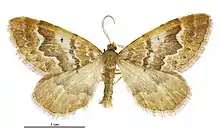Asaphodes exoriens
Asaphodes exoriens is a species of moth in the family Geometridae. This species is endemic to New Zealand.
| Asaphodes exoriens | |
|---|---|
 | |
| Male | |
| Scientific classification | |
| Kingdom: | Animalia |
| Phylum: | Arthropoda |
| Class: | Insecta |
| Order: | Lepidoptera |
| Family: | Geometridae |
| Genus: | Asaphodes |
| Species: | A. exoriens |
| Binomial name | |
| Asaphodes exoriens | |
| Synonyms[2] | |
| |
Taxonomy
This species was described by Louis Beethoven Prout in 1912 as Larentia exoriens using material collected by George Howes at Glenorchy in Otago in March.[2][3] George Hudson discussed and illustrated this species under the name Xanthorhoe exoriens in his 1928 publication The Butterflies and Moths of New Zealand.[4]
In 1987 Robin C. Craw proposed assigning this species to the genus Asaphodes.[5] In 1988 John S. Dugdale agreed with this proposal.[2] The holotype specimen is held at the Natural History Museum, London.[2]
Description
Hudson described the species as follows:
The expansion of the wings is 1 1⁄8 inches. All the wings are ochreous, the forewings being strongly tinged with reddish on the costa and extreme base; the median band consists of four very irregular faint blackish lines, the second and third lines forming three distinct loops; there is a distinct blackish discal dot and the outer edge of the median band is very strongly waved, with distinct projections above and below the middle; the subterminal area is broad with one or two very faint cloudy marks; all the wings have a terminal series of minute brown marks, and all the cilia are plain ochreous without bars. The underside of the hind-wings is dull reddish-ochreous without bars. The underside of the hind-wings is dull reddish-ochreous without distinct markings.[4]
Distribution
This species is endemic to New Zealand.[1][6] It has only been found in Central Otago.[4]
Biology and life cycle
A. exoriens is on the wing in March.[4]
Habitat and host species
A. exoriens is an alpine species that frequents open grassy habitat.[4][7] The adult moths are found in upland wetland habitat at altitudes of between 800-1100m.[8]
References
| Wikimedia Commons has media related to Asaphodes exoriens. |
- "Asaphodes exoriens (Prout, 1912)". www.nzor.org.nz. Landcare Research New Zealand Ltd. Retrieved 21 August 2018.
- Dugdale, J. S. (1988). "Lepidoptera - annotated catalogue, and keys to family-group taxa" (PDF). Fauna of New Zealand. 14: 173. Retrieved 21 August 2018.
- Prout, L. B. (1912). "Notes on the nomenclature of the New Zealand Geometridae, with descriptions of a new species". Transactions and Proceedings of the New Zealand Institute. 44: 52–54 – via Biodiversity Heritage Library.
- Hudson, G. V. (1928). The Butterflies and Moths of New Zealand. Wellington: Ferguson & Osborn Ltd. p. 121. OCLC 25449322.
- Craw, R. C. (2 February 2012). "Revision of the genus Helastia sensu stricto with description of a new genus (Lepidoptera: Geometridae: Larentiinae)". New Zealand Journal of Zoology. 14 (2): 269–293. doi:10.1080/03014223.1987.10422997.
- Gordon, Dennis P., ed. (2010). New Zealand Inventory of Biodiversity, Volume Two, Kingdom Animalia: Chaetognatha, Ecdysozoa, Ichnofossils. Vol. 2. Christchurch, N.Z.: Canterbury University Press. p. 459. ISBN 9781877257933. OCLC 973607714.
- Dickinson, K. J. M.; Mark, A. F.; Barratt, B. I. P.; Patrick, B. H. (March 1998). "Rapid ecological survey, inventory and implementation: A case study from Waikaia Ecological Region, New Zealand". Journal of the Royal Society of New Zealand. 28 (1): 83–156. doi:10.1080/03014223.1998.9517556. ISSN 0303-6758.
- Patrick, Brian (2014). "Ecology and conservation of the rare moth Asaphodes frivola Meyrick" (PDF). Weta. 47: 17–38. Archived from the original (PDF) on 2016-01-27.